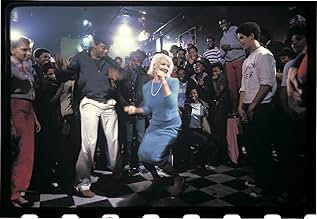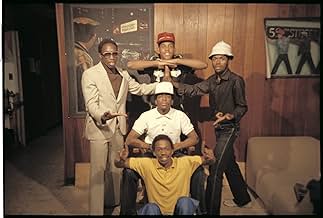Ajouter une intrigue dans votre langueSouth Bronx graffiti artist Zoro is commissioned to paint a backdrop for a hip-hop concert.South Bronx graffiti artist Zoro is commissioned to paint a backdrop for a hip-hop concert.South Bronx graffiti artist Zoro is commissioned to paint a backdrop for a hip-hop concert.
Lee Quiñones
- Raymond 'Zoro'
- (as 'Lee' George Quinones)
Lady Pink
- Rose 'Lady Bug'
- (as Sandra 'Pink' Fabara)
Fab 5 Freddy
- 'Phade'
- (as Frederick Braithwaite)
Andrew Witten
- Z-Roc
- (as Zephyr)
William Rice
- Television Producer
- (as Bill Rice)
Daze
- Union Crew
- (as Chris 'Daze' Ellis)
Histoire
Le saviez-vous
- AnecdotesThe stick-up guys were cast when Charlie Ahearn saw them hanging around the location. Ahearn offered them a prop gun but they insisted on using their real sawed-off shotgun. All of their lines were improvised.
- GaffesAt 6:18 Hector tells Raymond 'Zoro' to take off his do-rag. Then Ray's hair pops back and forth between being flat from the do-rag to a picked out Afro during their conversation.
- ConnexionsEdited into And You Don't Stop: 30 Years of Hip-Hop (2004)
Commentaire en vedette
Wild Style is not a documentary, despite what it may look like from packaging or even camerawork. It's a pretty slow-moving story of a man who writes on walls and his girlfriend's alleged infidelity with another man who writes on walls. While this love triangle is being played out, there is a journalist woman who wants to find out about a new sub-culture that is happening in the Bronx. There is also a musical event being planned in the amphitheatre in the park to showcase the local musical talent.
If you were reading the synopsis to this film anywhere, it would probably read something like that. But Wild Style isn't about the story. It's not about the acting, the direction or even the camerawork or sound recording (although the soundtrack is important).
It is a film that has shaped a generation, purely with the members of the cast and the records used in the soundtrack. Wild Style is a historical document. It perfectly captures a time and place - the Bronx, New York 1982 - and most of the figures that made that time and place so special. The plot is merely a device with which to string along a series of scenes of rappers, DJs, B-boys and spraycan artists. Some of these people were the roots of the hip hop movement. To see the impact that this film has had, look at how many times the soundtrack has been sampled - not only the dialogue (Tommy Tee, Beastie Boys, Cypress Hill, DJ Premier) but the backing loops. 'Tracks' such as Down By Law have become standards - no, classics - in battle cyphers and old school hip hop nights all over the world.
It's basically a visual dictionary of Old School hip hop royalty -
* GrandMaster Flash in what looks suspiciously like his bedroom cutting up the Headhunters' "God Made Me Funky" and then Bob James' "Take Me To The Mardi Gras" (although on the UK video re-release it has been replaced on the soundtrack with a Chris Stein co-produced track from the OST).
* The Rock Steady Crew intercut with Flash, walking up the hill in the park with a roll of lino on their shoulders.
* Fab 5 Freddy as the svengali of the film, leading others into the realms of the hip hop landscape (and hustling other members of the cast for money with card tricks).
* The Cold Crush Brothers and the Fantastic (Romantic) MCs in the basketball court.
* Double Trouble on the stoop ("Here's a little story that must be told...").
* 'Lee' Quinones and Lady Pink doing their thang on the walls of NYC - Lee's 'hands' piece being done at the same time as the RSC break and GM Flash cuts.
But enough of my salivating. This film is a slice of history for hip hop fans as much as footage of the 1966 World Cup Final is for British football fans. It should really be watched along with two other essential old school hip hop films - Beat Street (1984) and Beat This - A Hip Hop History (a BBC-TV film, 1985). Watching all three of those in one is an absolute education for anyone out there who has even a passing interest in hip hop (or even just rap) music. As a film, OK, it's limited and trite. The plot is pretty much non-existent and the acting is pretty variable. But no-one should watch it for that. Its whole reason d'etre is to provide an overview of a time and a place, when hip hop was innocent and a way of life, instead of a calculated business venture.
Beat Street was a bigger budget version of Wild Style, even down to the big name guest stars, the graffiti-artist-being-thwarted theme and the big show at the end of the film. It's easier to watch, but doesn't have that raw, cinema-verite style that Wild Style has.
Some trivia on the film. Chris Stein from Blondie co-produced he backing soundtracks that the MCs rap over. The records that the DJs use were pressed in very VERY limited quantities, and were not the result of crate digging. They were made for the film... According to popular legend, the opening scene of the (graffiti) bombing of the train was the only scene that Charlie Ahearne - director - could get the money together to do 'properly' (ie legally). If the rumours are to believed, the rest of the film was done 'on the run' - without permission.
If you like hip hop, are interested in it or even if you have never really thought about it, then watch Wild Style. It sums up a place and time and a FEELING quite unlike anything else. Now hip hop is the world's biggest selling music, watch this film to see where it came from. It'll probably make you reach for the nearest tracksuit, Kangol and lino and have you down the park in a fit of nostalgia.
If you were reading the synopsis to this film anywhere, it would probably read something like that. But Wild Style isn't about the story. It's not about the acting, the direction or even the camerawork or sound recording (although the soundtrack is important).
It is a film that has shaped a generation, purely with the members of the cast and the records used in the soundtrack. Wild Style is a historical document. It perfectly captures a time and place - the Bronx, New York 1982 - and most of the figures that made that time and place so special. The plot is merely a device with which to string along a series of scenes of rappers, DJs, B-boys and spraycan artists. Some of these people were the roots of the hip hop movement. To see the impact that this film has had, look at how many times the soundtrack has been sampled - not only the dialogue (Tommy Tee, Beastie Boys, Cypress Hill, DJ Premier) but the backing loops. 'Tracks' such as Down By Law have become standards - no, classics - in battle cyphers and old school hip hop nights all over the world.
It's basically a visual dictionary of Old School hip hop royalty -
* GrandMaster Flash in what looks suspiciously like his bedroom cutting up the Headhunters' "God Made Me Funky" and then Bob James' "Take Me To The Mardi Gras" (although on the UK video re-release it has been replaced on the soundtrack with a Chris Stein co-produced track from the OST).
* The Rock Steady Crew intercut with Flash, walking up the hill in the park with a roll of lino on their shoulders.
* Fab 5 Freddy as the svengali of the film, leading others into the realms of the hip hop landscape (and hustling other members of the cast for money with card tricks).
* The Cold Crush Brothers and the Fantastic (Romantic) MCs in the basketball court.
* Double Trouble on the stoop ("Here's a little story that must be told...").
* 'Lee' Quinones and Lady Pink doing their thang on the walls of NYC - Lee's 'hands' piece being done at the same time as the RSC break and GM Flash cuts.
But enough of my salivating. This film is a slice of history for hip hop fans as much as footage of the 1966 World Cup Final is for British football fans. It should really be watched along with two other essential old school hip hop films - Beat Street (1984) and Beat This - A Hip Hop History (a BBC-TV film, 1985). Watching all three of those in one is an absolute education for anyone out there who has even a passing interest in hip hop (or even just rap) music. As a film, OK, it's limited and trite. The plot is pretty much non-existent and the acting is pretty variable. But no-one should watch it for that. Its whole reason d'etre is to provide an overview of a time and a place, when hip hop was innocent and a way of life, instead of a calculated business venture.
Beat Street was a bigger budget version of Wild Style, even down to the big name guest stars, the graffiti-artist-being-thwarted theme and the big show at the end of the film. It's easier to watch, but doesn't have that raw, cinema-verite style that Wild Style has.
Some trivia on the film. Chris Stein from Blondie co-produced he backing soundtracks that the MCs rap over. The records that the DJs use were pressed in very VERY limited quantities, and were not the result of crate digging. They were made for the film... According to popular legend, the opening scene of the (graffiti) bombing of the train was the only scene that Charlie Ahearne - director - could get the money together to do 'properly' (ie legally). If the rumours are to believed, the rest of the film was done 'on the run' - without permission.
If you like hip hop, are interested in it or even if you have never really thought about it, then watch Wild Style. It sums up a place and time and a FEELING quite unlike anything else. Now hip hop is the world's biggest selling music, watch this film to see where it came from. It'll probably make you reach for the nearest tracksuit, Kangol and lino and have you down the park in a fit of nostalgia.
- stupid_fresh
- 22 oct. 2001
- Lien permanent
Meilleurs choix
Connectez-vous pour évaluer et surveiller les recommandations personnalisées
- How long is Wild Style?Propulsé par Alexa
Détails
Box-office
- Brut – à l'échelle mondiale
- 4 948 $ US
Contribuer à cette page
Suggérer une modification ou ajouter du contenu manquant

Lacune principale
By what name was Wild Style (1982) officially released in Canada in English?
Répondre
























